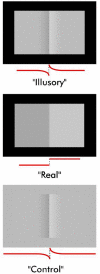Responses to lightness variations in early human visual cortex
- PMID: 17540572
- PMCID: PMC1931490
- DOI: 10.1016/j.cub.2007.05.005
Responses to lightness variations in early human visual cortex
Abstract
Lightness is the apparent reflectance of a surface, and it depends not only on the actual luminance of the surface but also on the context in which the surface is viewed [1-10]. The cortical mechanisms of lightness processing are largely unknown, and the role of early cortical areas is still a matter of debate [11-17]. We studied the cortical responses to lightness variations in early stages of the human visual system with functional magnetic resonance imaging (fMRI) while observers were performing a demanding fixation task. The set of dynamically presented visual stimuli included the rectangular version of the classic Craik-O'Brien stimulus [3, 18, 19] and a variant that led to a weaker lightness effect, as well as a pattern with actual luminance variations. We found that the cortical activity in retinotopic areas, including the primary visual cortex (V1), is correlated with context-dependent lightness variations.
Figures




References
-
- Gilchrist A, Kossyfidis C, Bonato F, Agostini T, Cataliotti J, Li XJ, Spehar B, Annan V, Economou E. An anchoring theory of lightness perception. Psychological Review. 1999;106:795–834. - PubMed
-
- Blakeslee B, McCourt ME. A multiscale spatial filtering account of the Wertheimer-Benary effect and the corrugated Mondrian. Vision Research. 2001;41:2487–2502. - PubMed
-
- Land EH, McCann JJ. Lightness and retinex theory. Journal of the Optical Society of America. 1971;61:1–11. - PubMed
-
- Rudd ME, Zemach IK. The highest luminance anchoring rule in achromatic color perception: Some counterexamples and an alternative theory. Journal of Vision. 2005;5:983–1003. - PubMed
-
- Adelson EH. Perceptual organization and judgment of brightness. Science. 1993;262:2042–2044. - PubMed
Publication types
MeSH terms
Grants and funding
LinkOut - more resources
Full Text Sources

